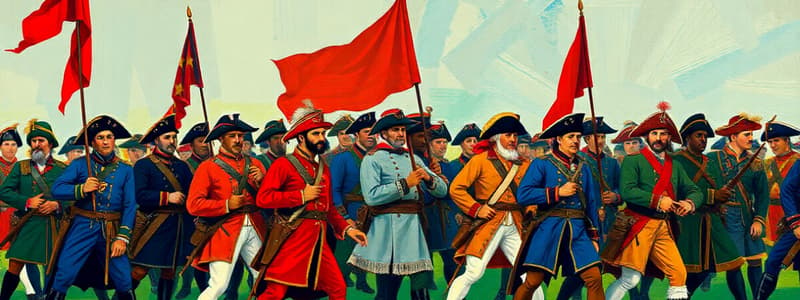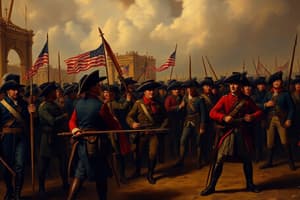Podcast
Questions and Answers
How did matching the sketch's inscription to a contemporary newspaper article contribute to validating the artwork's historical context?
How did matching the sketch's inscription to a contemporary newspaper article contribute to validating the artwork's historical context?
- It confirmed the artwork was created after the Battle of Brandywine, providing a definitive end date for its creation.
- It helped decipher missing words, corroborating the depicted event with independent documentation and verifying the troop's itinerary. (correct)
- It revealed the presence of female followers in the Continental Army, proving their involvement in military strategies.
- It authenticated the artist's signature, confirming Pierre Eugene du Simitiere as the sketch's creator and guaranteeing its value.
What is the most significant contribution of the Revolutionary War sketch to the understanding of the Continental Army's daily operations?
What is the most significant contribution of the Revolutionary War sketch to the understanding of the Continental Army's daily operations?
- It offers a visual record of the diverse experiences of the troops, including their mundane routines, hardships, and moments of joy. (correct)
- It includes exact names and ranks of officers, allowing historians a new method to cross-reference military personnel records.
- It lists all of the expenses incurred during the depicted march, offering accounting details about supply chains.
- It provides detailed schematics of military strategies and tactical formations employed during the war.
In what way does the Revolutionary War sketch challenge or expand traditional understandings of the Continental Army?
In what way does the Revolutionary War sketch challenge or expand traditional understandings of the Continental Army?
- By illustrating the substantial presence and vital roles of women within the army, countering their frequent omission from historical accounts. (correct)
- By revealing the army's use of experimental weaponry, challenging preconceived notions about their technological capabilities.
- By disproving previous assumptions regarding the role of Native American scouts in guiding troop movements.
- By introducing a new perspective on wartime logistics, showcasing the army's reliance on complex supply chains managed exclusively by civilian contractors.
How does the identification of Pierre Eugene du Simitiere as the artist enhance the historical value and interpretation of the Revolutionary War sketch?
How does the identification of Pierre Eugene du Simitiere as the artist enhance the historical value and interpretation of the Revolutionary War sketch?
What is the likely reason the sketch was donated to a museum for public display in April 2024?
What is the likely reason the sketch was donated to a museum for public display in April 2024?
What initially prompted Matthew Skic, curator at Philadelphia's Museum of the American Revolution, to suspect the drawing's historical significance?
What initially prompted Matthew Skic, curator at Philadelphia's Museum of the American Revolution, to suspect the drawing's historical significance?
Why would the detail of the soldier's shirt 'set off alarm bells' in Matthew Skic's mind?
Why would the detail of the soldier's shirt 'set off alarm bells' in Matthew Skic's mind?
What can be inferred from the discovery that the drawing was purchased in the mid-1970s but its historical significance was not realized until 2023?
What can be inferred from the discovery that the drawing was purchased in the mid-1970s but its historical significance was not realized until 2023?
Given the drawing depicts a scene with soldiers, women, a baby, and a supply-filled carriage; what can be assumed?
Given the drawing depicts a scene with soldiers, women, a baby, and a supply-filled carriage; what can be assumed?
The article mentions that the back of the drawing features five rough drafts of two men. What does the existence of these drafts suggest about the artist/artwork?
The article mentions that the back of the drawing features five rough drafts of two men. What does the existence of these drafts suggest about the artist/artwork?
Flashcards
Revolutionary War Sketch
Revolutionary War Sketch
A 15 by 5 inch artwork depicting Revolutionary War troops.
North Carolina Brigade
North Carolina Brigade
Continental troops that marched through Philadelphia in August 1777.
Pierre Eugene du Simitiere
Pierre Eugene du Simitiere
Swiss artist known for Revolutionary War sketches and creator of this artwork.
Eyewitness Drawing
Eyewitness Drawing
Signup and view all the flashcards
Female Followers of the Army
Female Followers of the Army
Signup and view all the flashcards
Revolutionary War Drawing
Revolutionary War Drawing
Signup and view all the flashcards
Judith Hernstadt
Judith Hernstadt
Signup and view all the flashcards
Matthew Skic
Matthew Skic
Signup and view all the flashcards
Continental Army
Continental Army
Signup and view all the flashcards
Eyewitness sketch
Eyewitness sketch
Signup and view all the flashcards





